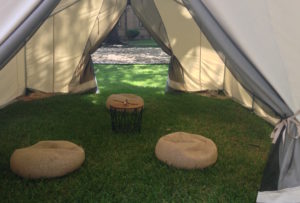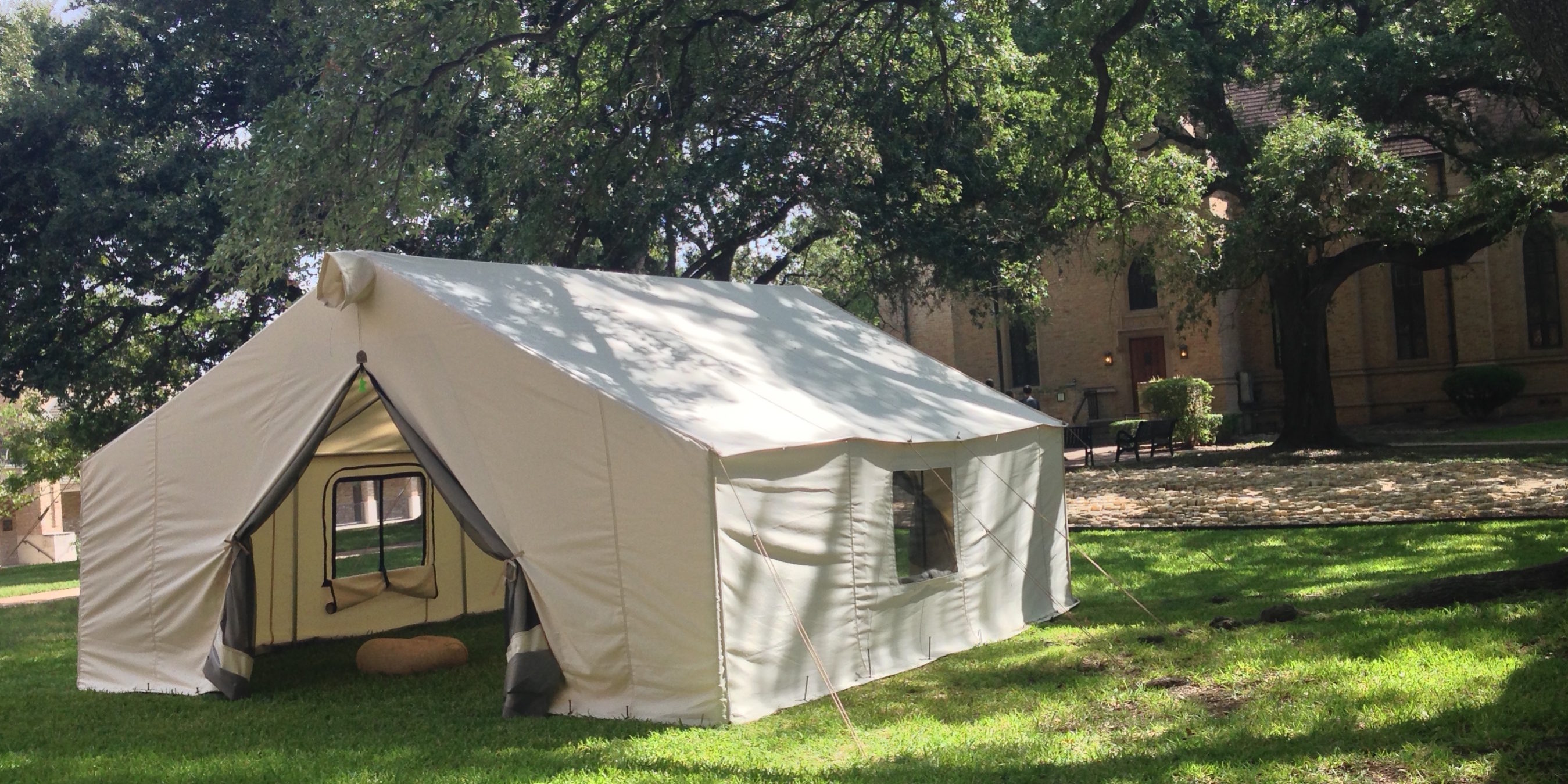This is supposed to be a blog post about a tent, or more specifically our raising of a tent, so I want to be true to that intention and not leave our poor, wonderful tent out in the cold. So here’s the long and short of it: We have a tent, purchased through a grant provided by Duke University’s Foundations of Christian Leadership program. It’s a beautiful canvas configuration, made by a fantastic family of tentmakers in Denver. Their company has been outfitting high country hunters and adventurers for most of last century, and you can learn more about them here. Our first foray with the tent on campus took place in late August, when we built the tent as a place of quiet respite and reflection for the new class of seminarians who were facing the overwhelming task of understanding EVERYTHING about seminary over the course of their three day orientation, and for all the people traversing our campus towards the University of Texas at Austin, also, doubtless, full of the fear, excitement, and clueless ambiguity that define the start of all new things. And for everyone, really, who just needs a little quiet and some shade.
But how can we talk about tents, or any intentional dwelling, without talking about who is inside? Or rather, who isn’t? For us, in the scorching heat of late August, getting the tent on its’ feet felt like a success. I saw a few people go in, and got a few bits of positive feedback. The most gratifying moments were to see people who cross our campus daily stop for once, and look a little longer, or smile slightly at the curiosity of what was inside, maybe stopping to consider if they were invited (they were). Hopefully our next go round will invite more engagement, more lingering. After all, these young people passing by, full of curiosity, timid about invitation, are the heart of our work. And in these young people, I would argue, we are learning to see much more of the world outside the church. All the “threshold people” who are waiting, curious, searching, ready to learn and to teach us how to be the expansive kingdom people that God calls us to be.

This leads me to the primary topic of this post, which is my ongoing fascination with “threshold people” and the church’s capacity to better understand itself in the mirror they provide for us in the current religious climate. Last year, in the basement of the seminary library, I stumbled upon a book that helped me fall in love with prayer again and also began to give me solid language and encouragement around this challenge of simultaneously reaching and learning from threshold spaces and those that populate them. It was written by a now-deceased Anglican priest named Jim Cotter, and I’ve since ordered a small library of his work. He uses language in a way that is both raw and heightened, traditional and invitational. And the way he imagines the work and call of the church through both contemplation and hospitality feels very in-line with the needs and desires of many of the young people crossing our path. One of his most relevant books on this topic is “Love Rekindled: Practising Hospitality.” Written in 1996, chapter titles read like a manual for reclaiming some our most authentic values as a church. Some examples include:

Taking care of the boundaries
Welcoming across the threshold
Befriending the stranger
Nurturing the vulnerable
Bearing the hurts
Feasting with the guests
Listening to the ancestors
If I had to recommend a manual for starting a young adult endeavor at this point, I think it would be this book. Most particularly because of his use and understanding of the concept “Threshold People,” which describes the growing majority of Americans as they understand and name themselves in relationship to the church, particularly those under the age of 40. His chapter on “Welcoming Across the Threshold” accentuates the need for thorough and inviting threshold spaces to invite and make comfortable those that stand at the margins, full of questions and spiritual longings that they themselves may not fully understand. These are the Threshold People he names, and hopes to encourage to draw near.
Claiming the space, or in our case, building the tent, is only the first part of the work. In our space, and in any spaces we support in creation, we strive for a sense of hospitality that goes beyond invitation and welcome, and really gets to the question of access. In these spaces, the hospitality must continue so that each person feels capacity for participation, and a berth wide enough that they find room for both their questions and the grace of God’s spirit when they enter such spaces. Jim Cotter provides a beautiful description of such a space when describing the missionality of his rambling repurposed vicarage:
Hospitality, then, and a place for prayer and reflection in the city, in a house with an immediate vista of an urban landscape of industry, schools, hospitals, and houses, yet with open space nearby and views across the city to the moors of the Pennines. It is a place for the kind of prayer which pays attention to all this, to whatever is happening in our private and corporate lives, the prayer which is itself hospitable to questions about those lives- and to questions about faith in troubling times- in a spirit of encouragement and challenge, the prayer which becomes still and silent. Out of the weaving of these three strands of attention, question, and silence there can come the creation of something new, which will always be the unexpected gift, maybe to be shared with the host, certainly to take away and to share with others.

We hope to continue to raise the tent, to provide spaces to pay attention, to question, and to indulge in silence. Hopefully you will join us, or consider creating your own endeavor. Either way, may the silence invite the beginning of something new in all of us, in those we serve, and in those not yet adequately served by the church but at our threshold, full of yearning.







